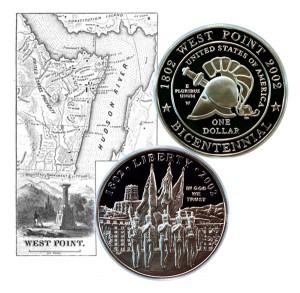Today, the West Point Commemorative Silver Dollar Coin remembers the West Point of revolutionary times and the Congressional approval for the Military Academy, 214 years ago.
In the Pictorial Field-book of the Revolution, published in 1852, Benson John Lossing wrote:
=====
To defend Fort Clinton, and more thoroughly to secure the river against the passage of an enemy’s fleet, it was thought advisable to fortify the heights in the neighborhood.
The foundation of a strong fort was accordingly laid on Mount Independence, and, when completed, it was named Putnam, in honor of the commander of the post.
On eminences south of it, Forts Webb, Wyllys, and other redoubts were constructed; and at the close of 1779, West Point was the strongest military post in America.
In addition to the batteries that stood menacingly upon the hill tops, the river was obstructed by an enormous iron chain, the form and size of which is noted on page 132.
The iron of which this chain was constructed was wrought from ore of equal parts, from the Stirling and Long Mines, in Orange county.
The chain was manufactured by Peter Townshend, of Chester, at the Stirling Iron Works, in the same county, which were situated about twenty-five miles back of West Point.
The general superintendent of the work, as engineer, was Captain Thomas Machin, who afterward assisted in the engineering operations at Yorktown, when Cornwallis was captured.
The chain was completed about the middle of April, 1778, and on the 1st of May it was stretched across the river and secured.
When Benedict Arnold was arranging his plans to deliver West Point and its dependencies into the hands of the enemy, this chain became a special object of his attention.
And it is related that, a few days before the discovery of his treason, he wrote a letter to Andre, in a disguised hand and manner, informing him that he had weakened the obstructions in the river by ordering a link of the chain to be taken out and carried to the smith, under a pretense that it needed repairs.
He assured his employer that the link would not be returned to its place before the forts should be in possession of the enemy.
West Point was considered the keystone of the country during the Revolution, and there a large quantity of powder, and other munitions of war and military stores, were collected.
These considerations combined, made its possession a matter of great importance to the enemy, and hence it was selected by Arnold as the prize which his treason would give as a bribe.
When peace returned, it was regarded as one of the most important military posts in the country, and the plateau upon the point was purchased by the United States government.
Repairs were commenced on Fort Putnam in 1794, but little was done.
Not being included in the government purchase, the owner of the land on which the fort stood felt at liberty to appropriate its material to his private use, and for years the work of demolition was carried on with a Vandal spirit exercised only by the ignorant or avaricious.
It was not arrested until Congress purchased the Gridly Farm, on which the fort stood, in 1824, when the work had become almost a total ruin.
The Military Academy at West Point was established by an act of Congress, which became a law on the 16th of March, 1802.
Such an institution, at that place, was proposed by Washington to Congress in 1793; and earlier than this, even before the war of the Revolution had closed, he suggested the establishment of a military school there.
But little progress was made in the matter until 1812, when, by an act of Congress, a corps of engineers and of professors were organized, and the school was endowed with the most attractive features of a literary institution, mingled with that of the military character.
From that period until the present, the academy has been increasing in importance, in a military point of view.
Over three thousand young men have been educated there, and, under the superintendence of Major Delafield, who was appointed commandant in 1838, it continues to flourish.
The value of the instruction received there was made very manifest during the late war with Mexico; a large portion of the most skillful officers of our army, in that conflict, being graduates of this academy.
The winding road from Fort Putnam to the plain is well wrought along the mountain side, but quite steep in many places.
A little south of it, and near the upper road leading to the stone quarries and Mr. Kingsley’s, are the ruins of Fort Webb, a strong redoubt, built upon a rocky eminence, and designed as an advanced defense of Fort Putnam.
A short distance below this, on another eminence, are the remains of Fort Wyllys, a still stronger fortification.
…
=====
The West Point Commemorative Silver Dollar Coin shows with the map of the area, circa 1850s, from Mr. Lossing’s book.
